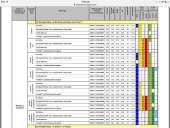Hi folks!
I've been planning a small wooden house to build in a small property I'm developing. I chose wood considering cost (I get a local carpenter to build it) and also because it feels more "natural".
Recently I began doing more research on earthships and passive houses, and would love to get something like that. Unfortunately, the costs and resources are out of my reach.
So, I've been redesigning the wood house to integrate more principles from earthships and passive house design. I would like to discuss it with someone who has a bit more experience, just to check if I'm not making some major mistakes. I don't expect the wood house to perform as good, but as long as its better than standard wooden houses, its already a win! I just don't want to make things that won't work because I didn't do X, Y or Z as well!
Here's a photo of my current house plan:
https://i.imgur.com/sl6XGJw.png
So these are basically my questions:
1 - the south(sun)-facing wall will just be vertical, and not tilted like in an earthship. Would that be a problem?
2 - do I need to integrate some sort of window on the roof to allow hot air to escape, or opening the wall windows will be enough?
3 - I wont have enough room to place a rocket mass heater(which would be amazing!), so probably a standard wood-stove will have to do it. I can try to put some more mass around it, to hold heat. But will it be enough to get hot air to the rooms?
4 - Not having windows anywhere except south makes sense, but in this case, will it be worst since I wont have enough air movement to take hot air out?
5 - (related with previous) will I be able to implement a cooling vent (underground) like earthships do, in this kind of design? will it work at all or do I need some more elements to get the convection thing working?
sidenotes:
* I plan to have plants to provide shade both on the south and west side
* the roof overhang will be enough to cut most of the summer sun from the windows
* the bathroom location is on the west to act as an extra barrier between the sun and the bedroom... but I know it should be near to the kitchen for more efficient plumbing, hot water, etc.
Any other tips or advice?
thanks in advance!!




























 But like I said, I'm not trying to achieve 100% efficiency, rather just to improve on a standard wood house design
But like I said, I'm not trying to achieve 100% efficiency, rather just to improve on a standard wood house design

















